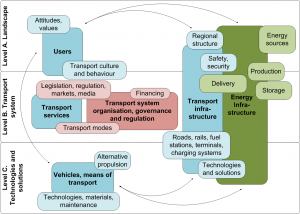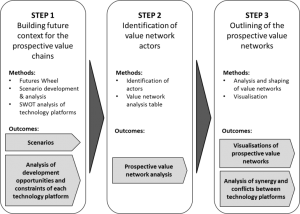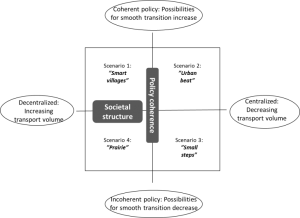If the Nordic energy and transport sectors are to meet the 2050 energy and climate policy targets, major systemic chang-es are necessary. The transition requires cooperation between public and private actors. The approach outlined in the paper combines elements from the fields of system level changes (transitions), value chain analysis and forward looking policy design. It presents a novel, policy relevant application with a set of practical tools to support development of im-plementation strategies and policy programmes in the fields of energy and transport.
A Major Transition is Necessary
Sustainable energy technologies are driven especially by the climate change challenge, which necessitates paradigm shift also in global energy production and consumption structures. Currently, about 20 % of the Nordic CO2 emissions are due to transport sector. If the Nordic energy and transport systems are to meet the 2050 energy and climate policy goals, a major transition is necessary. Along with new technologies, changes are required also in other societal sectors such as business models and consumer habits. The transition requires cooperation between public and private actors. Political decisions should create potential to enterprises which can provide renewable energy solutions in a way that they attract also consumers and transporters of goods.
In order to be able to make wise political decisions we need foresight actions to get an idea about the future trends and needs, and possible ways of shaping the future. We believe that, for the most part, actors create the future and therefore the state of the transport system is a result of the measures and actions carried out by the producers, operators and users of the system. Therefore we need knowledge and understanding about the actors who are important in the processes. In our understanding actors are outlined in value chains.
A new Approach to Value Chains
The focus in this brief is on developing tools to understand, create and analyse prospective value chains up to the year 2050. With ‘value chain’ we mean a chain of activities needed in order to deliver a specific valuable product and service for the market, incl. activities related to energy sources or feedstock production; energy production; distribution and transportation; retail; consumption; regulation and governance; and research and development. In our case the value chains arise from three alternative, but partly overlapping technology platforms, namely electricity, biofuels and hydrogen.
The motivation for this foresight exercise is to produce knowledge for future decision making and policy support in order to create enabling ground for sustainable energy solutions for the future transport sector. Traditionally value chains are considered in rather short term business opportunity analyses. In our case, we need to outline the value chains in the far future.
The brief is based on the preliminary results of the TOP-NEST project WP4. The task of WP4 is to identify prospective value chains in order to outline roadmap and policy recommendations in the later phases of the project.
Functions of Foresight and Policy-making
The impact of foresight on policy-making has been discussed among foresight experts practitioners (e.g. Georghiou & Keenan 2006, Da Costa et. al. 2008, Weber et.al. 2009, Könnölä e.al. 2009, 2011). One aspect of this discussion is to consider the functions of foresight in policy-making. The functions of foresight can be summarized into three major functions, which are 1) informing, 2) facilitation, and 3) guiding.
The informing function of foresight is generation of insights regarding the dynamics of change, future challenges and policy options, along with new ideas, and transmitting them to policymakers as an input to policy conceptualisation and design.
Facilitation of policy implementation gets it motivation from the changing nature of policy-making. There has been a shift from linear models of policy-making, consisting of successive phases such as formulation, implementation and evaluation phases, into cyclic models, where evaluations are supposed to feed back into the policy formation and implementation phases (Weber et. al 2009; Da Costa et. al 2008). This kind of thinking puts more emphasis on interactions, learning, and decentralised and networked characters of political decision-making and implementation.
The effectiveness of policy depends also on the involvement of a broader range of actors, and therefore also, the role of government shifts from being a central steering entity to that of a moderator of collective decision-making processes. To meet the requirements of the new mode of operation one needs foresight instrument.
Policy guiding refers to the capacities of foresight to support strategy formation or policy definition. In its best foresight exercises may bring to light the inadequacy of the current policy system to address the major challenges that society is facing (Da Costa et al. 2008).
Our approach combines analysis of system level changes (transitions) and value chain analysis with foresight approach. We apply multilevel perspective model (Geels 2005) to define the prerequisites of the transfer of the complex transport system, and value chain analysis in order to concretise the changes needed. With these elements we try to inform, facilitate and guide policy-making.
Multi-level Perspectives of the Energy and Transport Systems
Figure 1 presents the three basic components of the transport system: users, vehicles and transport infrastructure. The use of vehicles involves behavioural and business models, and different types of solutions are available concerning issues such as vehicle ownership (adapted from Auvinen and Tuominen, 2012). The illustration presents also the main elements of the energy system (primary energy sources, production and storage), which are linked to the transport system mainly through energy and transport infrastructures and are crucial for transport operations.
The state of the transport system is a result of the measures and actions carried out by the producers, operators and users of the system. Producers and operators are organisations or companies, which can be categorised according to their main duties, such as: policy formulation, infrastructure construction and maintenance, production and operation of services for the transport system, and production of transport-related services (e.g. vehicle manufacturing and fuels). Individual people, actually the whole population, are the users of the passenger transport system. In freight transport, users are companies and organisations in the fields of industry, transport and commerce (Tuominen et al. 2007). Value chains are composed from these different actors.

Figure 1. Transport and energy systems in multi-level perspective model. The transfer process requires changes in all levels heading to the same direction.
From Future Wheel to Technology Platforms and Prospective Value Chains
The foresight procedure consists of three stages (see Figure 2):

Figure 2. A procedure for prospective value chain analysis.
The starting point of the process (Step 1) is to create an idea of the context were the prospective value chains will operate. For this pourpose, various foresight methods, such as Futures Wheel, and scenario methodology can be used. We formulated four different scenarios for 2050, which are described briefly below (Figure 3).

Figure3. The principle of scenario creation and the four transport scenarios formulated for 2050.
The goal of the second step is to identify the value network actors and analyse their individual interests, and connections between different actors, if possible, in all different scenarios. The analysis covers value chain activities from energy sources and feedstock production to energy production, distribution and transport, retail and consumption. Also regulation, governance and R&D actors are included in the analysis.
All possible actors are listed and their opportunities and advantages, as well as supportive needs are analysed. Opportunities refer to the possibilities to make profit in the value network (How the actor benefits from the value network?), and advantage refers to created value by the actor (What is the added value the actor produces to its customer or in the network?). The analysis of the supportive activities is needed to recognize the connection between different actors. Figure 4 gives an example of the value network illustration.

Figure 4. Value network of a biodiesel example based on tall oil.
The third step includes outlining of the prospective value chains. In this stage, couple of aspects need to be taken into consideration. Different technology platforms will co-exist in the future and different futures create different opportunities and development possibilities for different technology platforms. Therefore, one needs to describe the level of technological development of the given technology platform in the outline of the value chain. In other words, the outline of the value chain works only in selected scenario, and the level of technological development of a single technology platform is different in different scenarios.
Participative Workshops Informing, Facilitating and Guiding Policy-making
Future value chains and future actors within have to be recognised in order to find out prerequisites of the future actions. The proposed approach may act as a checklist for the key issues to be covered in outlining prospective value chains in the road transport context.
The process integrates methods from different theoretical starting points: foresight, multi-level perspective and value chain theories. It also integrates energy and transport systems, and expands the context far to the future. The process is not yet complete but the work will continue in the TOP-NEST project up to the 2014.
To outline future actors is a challenging task. At this stage of the process development we have noticed that the most challenging part is to be able to imagine potential new actors and to create potential new relationships between the actors in a strongly path dependent situation, as is a biodiesel case. We assume that for instance in testing this procedure in hydrogen technology system the challenge may be slightly easier, because path-dependency is not strong.
Another challenge is to get relevant stakeholders to either participate the workshops or give interviews. The workshops or interviews shall include stakeholders at least from the industry, ministries, NGO’s e.g. nature protection organisations, vehicle industry and associations as well as researchers. The issue to be discussed is so large including energy, transport and transition policies, that the discussion would take time. There may also be confidentiality problems concerning new emerging technologies.
We believe that the prospective value chain analysis helps us to figure out landscape level constraints, like values and global trends, niche level options, as well as the needs which guide us to change or maintain the existing regime. Value chain analysis gives us views about the future and about the potential paths and constraints to help making wise political decisions.
| Authors: | Nina Wessberg, nina.wessberg@vtt.fi, Anna Leinonen, anna.leinonen@vtt.fi, Anu Tuominen, anu.tuominen@vtt.fi, Annele Eerola, annele.eerola@vtt.fi ,Simon Bolwig, sibo@dtu.dk | ||||
| Sponsors: | NER (TOP-NEST project http://www.topnest.no/ ) | ||||
| Type: | Nordic foresight exercise | ||||
| Organizer: | VTT, nina.wessberg@vtt.fi | ||||
| Duration: | 2011-2015 | ||||
| Budget: | € 402,000 | ||||
| Time Horizon: | 2050 | ||||
| Date of Brief: | July 2014 | ||||
Download EFP Brief No. 257_Prospective Value Chains
Sources and References
Auvinen, H. & Tuominen, A. 2012, Safe and secure transport system 2100. Vision. VTT Technology 5 (2012).
Da Costa, O., Warnke, P., Cagnin, C., Scapolo, F. (2008) The impact of foresight on policy-making: insights from the FORLEARN mutual learning process. Technology analysis & Strategic Management, vol. 20, No. 3, pp. 369-387.
Geels, F.W. 2005, “Processes and patterns in transitions and system innovations: Refining the co
evolutionary multi-level perspective”, Technological Forecasting and Social Change, vol. 72, no. 6, pp. 681-696.
Georghiou, L., Keenan, M. (2006) Evaluation of national foresight activities: Assessing rationale, process and impact. Technological Forecasting & Social Change, vol. 73, pp. 761-777.
Könnölä, T., Scapolo, F., Desruelle, P., Mu, R. (2011) Foresight tackling societal challenges: Impacts and implications on policy-making. Futures vol. 43. pp. 252-264.
Tuominen, A., Järvi, T., Räsänen, J., Sirkiä, A. and Himanen, V. (2007) Common preferences of different
user segments as basis for intelligent transport system: case study – Finland. IET Intell. Transp. Syst.,
2007, 1, (2), pp. 59–68.
Tuominen, A., Wessberg, N., Leinonen, A., Eerola, A. and Bolwig, S. (2014). Creating prospective value chains for renewable road transport energy sources up to 2050 in Nordic Countries. Transport Research Arena 2014, Paris.
Weber, M., Kubeczko, K., Kaufmann, A., Grunewald, B. (2009) Trade-offs between policy impacts of future-oriented analysis: experiences from the innovation policy foresight and strategy process of the city of Vienna. Technology analysis & Strategic Management, vol. 21, No. 8. pp. 953-969.
Wessberg, N., Leinonen, A., Tuominen, A., Eerola, A. and Bolwig, S. (2013) Creating prospective value chains for renewable road trasport energy sources up to 2050 in Nordic Countries. International Foresight Academic Seminar in Switzerland, Sept 16-18, 2013.